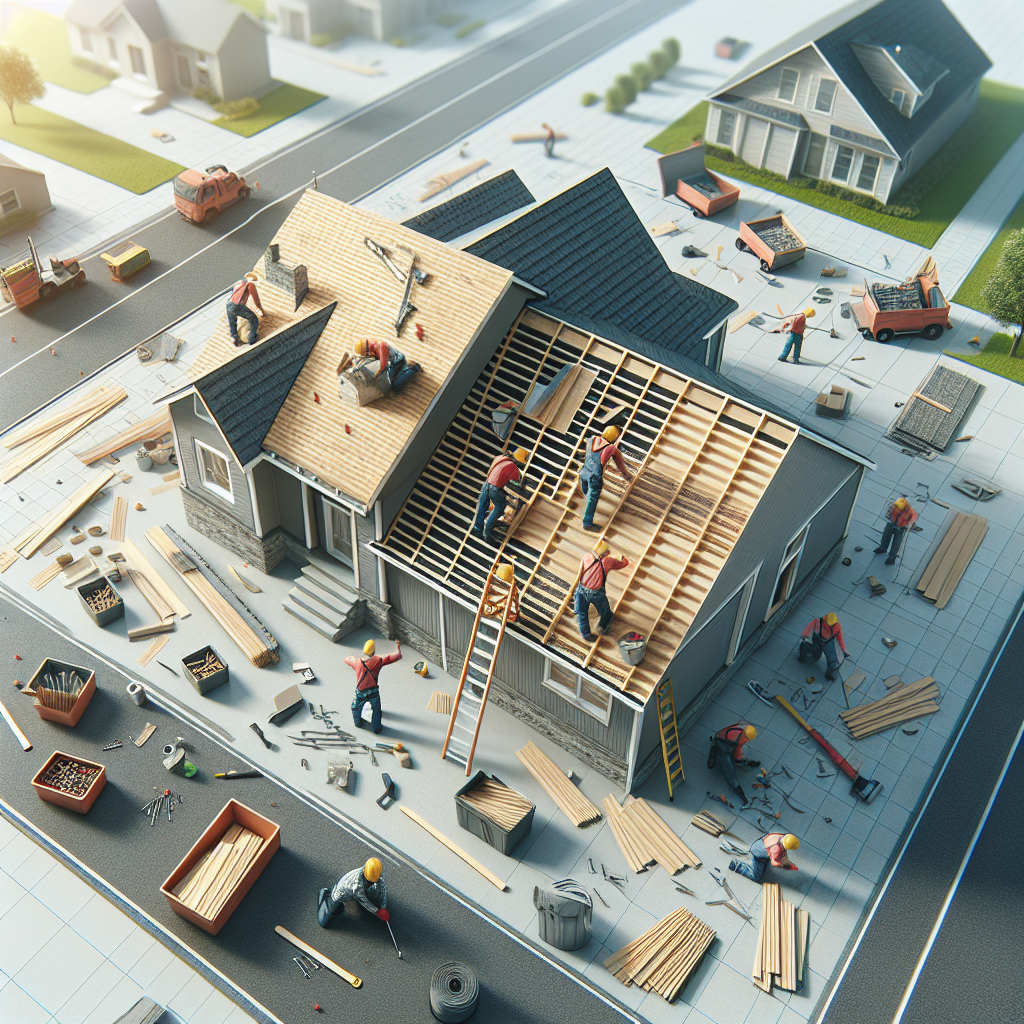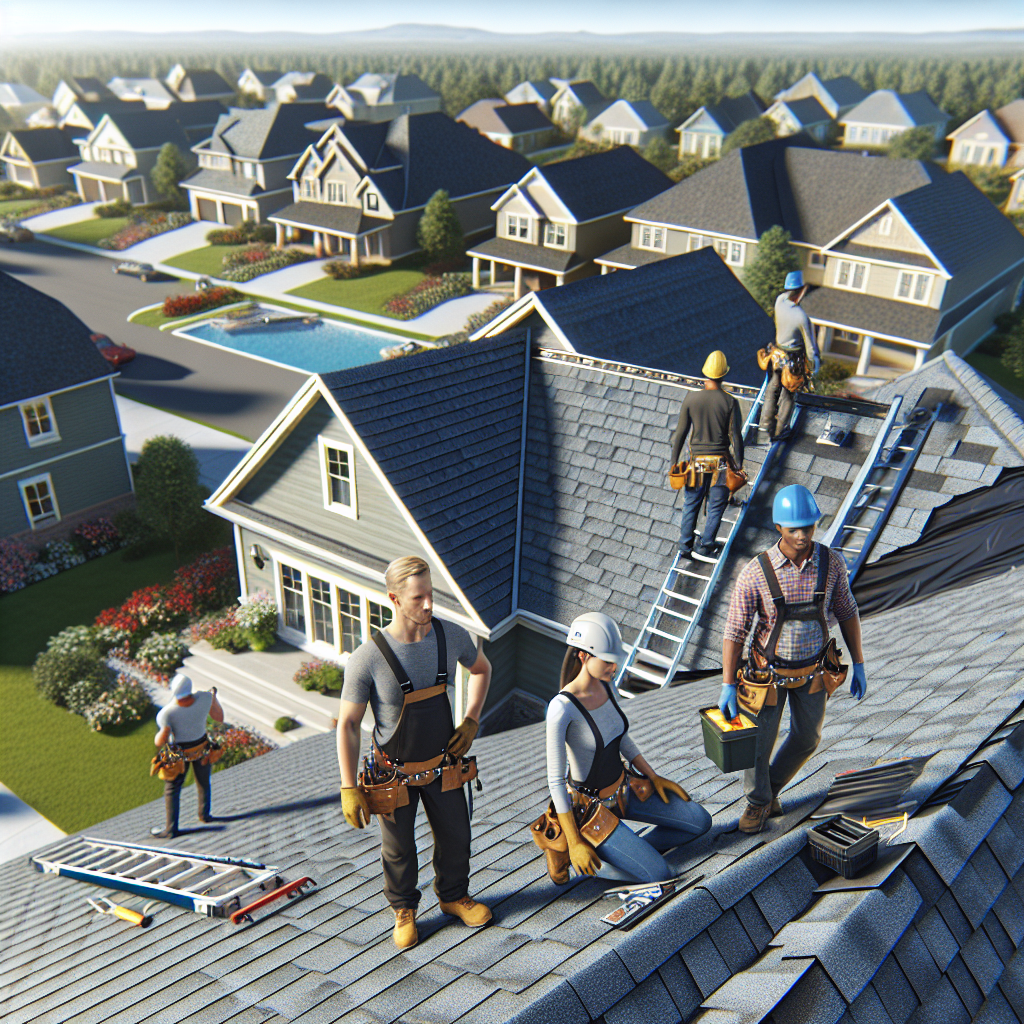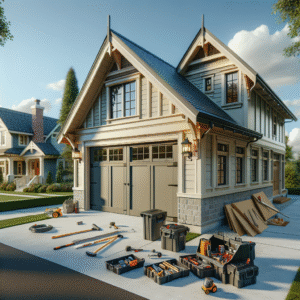Is it Time to Replace Your Roof?
Deciding whether to repair or replace your roof can be a daunting task. But fear not, as understanding the signs that indicate the need for a roof replacement is the first step towards ensuring your home remains safe and sound. From curled shingles to visible leaks, knowing when to invest in a new roof is crucial. This comprehensive guide aims to help you assess your roofing needs, select the best materials, and understand what to expect during the installation process.
1. Assessing Your Roofing Needs: Understanding When It’s Time for a Replacement
Roof replacements are a significant home improvement project, and it’s vital to recognize the signs that your roof may be nearing the end of its lifespan. Some key indicators include:
- Age of the roof: Most roofs are designed to last between 20 to 30 years.
- Visible damage: Look for missing, loose, or damaged shingles that can lead to leaks.
- Water damage inside your house: Stains on ceilings or walls can be a telltale sign of roof problems.
- Sagging roof deck: This could indicate structural issues that might require more than just a roofing job.
Regular inspections can help you catch these issues early and determine whether repair or full replacement is necessary.
2. Choosing the Right Materials for Your New Roof: Durability, Cost, and Aesthetic Considerations
When selecting roofing materials, balance durability, cost, and aesthetics. Options range from asphalt shingles to metal roofs, each with their own benefits and drawbacks:
- Asphalt shingles are cost-effective and widely available, but less durable than some alternatives.
- Metal roofs offer longevity and energy efficiency but are more expensive.
- Tile and slate provide distinctive aesthetics and extreme durability but can be heavy and require additional structural support.
Consider local climate conditions, your home’s architectural style, and budget when choosing your roofing material.
3. The Installation Process: What to Expect from Professional Roofing Services
Understanding the installation process can ease much of the stress associated with getting a new roof. A professional roofing installation typically involves:
- Initial consultation and roof inspection
- Choosing the right materials
- Removing the old roof
- Preparing the roof deck
- Installing the new roof
- Site cleanup and final inspection
Choose a reputable local contractor to ensure a smooth and successful installation. They can offer in-depth knowledge of regional weather patterns and building codes, which is invaluable for your roofing project.

If you’re ready to take your home improvement or construction project to the next level, we can help! Find trusted contractors on BuildNet, whether you’re looking for renovations, new builds, electrical work, plumbing, or anything in between. Our directory connects you with qualified professionals who can make your vision a reality.
Assessing Your Roofing Needs: Understanding When It’s Time for a Replacement
Hello there, homeowner! If you’re pondering whether it’s time to replace your roof, then you’re in the right place. Let’s delve into the nitty-gritty of roof assessments and uncover the telltale signs and factors that scream it’s time for a new roof. Don’t worry, I’m here to guide you through this crucial decision in a way that’s both informative and easy to digest.
Why Roof Replacement Might Be on Your Radar
Roofs are the unsung heroes of our homes, shielding us from the elements and contributing to our home’s overall aesthetics and structural integrity. However, they don’t last forever. Various factors like age, weather damage, and material degradation can diminish a roof’s ability to protect your home adequately. Understanding the why and when of roof replacement can save you from future headaches and potentially high repair costs.
1. Age of Your Roof
The age of your roof plays a pivotal role in determining whether it’s time for a replacement. Most experts agree that a typical asphalt shingle roof will last between 20 to 25 years. If your roof is approaching or has surpassed this age, it’s a good idea to start considering your options for a new roof. For other materials like metal, tile, or slate, this lifespan can be significantly longer, and knowing the specific material of your roof can help guide your decision.
2. Frequent Repairs
Have you been calling in the professionals more often than you’d like for roof repairs? Frequent issues can be a clear indicator that your roof system is failing. If you find yourself patching up one problem only to encounter another, it might be more cost-effective in the long run to opt for a replacement, rather than continuing to pour money into repairs.
3. Signs of Water Damage or Leaks
Water stains on your ceilings or walls can be a symptom of a leaking roof, and are definitely a red flag. Sometimes these leaks can be patched, but if you notice them becoming more frequent, it’s probably time to replace your roof. Water damage can compromise the structural integrity of your roof and even lead to health problems from mold and mildew growth.
4. Sagging and Structural Issues
If you notice a section of your roof starting to sag, this is a serious sign of structural issues. A sagging roof often suggests trapped moisture and weakening of the supporting structure, which could lead to a collapse if not addressed. This is usually a clear sign that a roof replacement is not just necessary but urgent.
5. Shingles: Curling, Missing, or Damaged
Take a look at the condition of your shingles. Are they curling at the edges? Do you see patches where shingles are missing or visibly damaged? These are signs that your roof’s ability to repel water and insulate your home could be compromised. Checking your roof after severe weather conditions, especially, can help you catch these issues early.
6. A Spike in Energy Bills
If you’ve noticed a sudden increase in your energy bills, it could be due to your roof underperforming. An old or damaged roof can lead to air leaks, and poor insulation, forcing your heating and cooling systems to work overtime to maintain a comfortable indoor temperature.
Getting Professional Advice
If you’re still unsure about whether it’s time for a roof replacement, consulting with a professional can provide clarity. A licensed roofing contractor can offer a detailed inspection and give you a better idea of the condition of your roof and whether minor repairs or a full replacement are necessary.
Consider Your Local Climate
Last but not least, consider your local climate when assessing your roofing needs. Harsh weather conditions, such as heavy snowfall, hurricanes, or high temperatures, can accelerate the aging process of your roof. Homeowners in areas prone to severe weather should be particularly vigilant about roof inspections and maintenance.
Deciding whether to replace your roof is a big decision and understanding the condition and age of your roof, the frequency of repairs, signs of damage, and local weather conditions can help guide your choice. Remember, a timely replacement can not only ensure the safety and efficiency of your home but also enhance its curb appeal and potentially increase its market value.

Choosing the Right Materials for Your New Roof: Durability, Cost, and Aesthetic Considerations
Hey there! If you’re on a quest to spruce up your abode with a new roof, you’re probably pondering over what materials to choose. It’s a big decision, and we want to make it as easy as possible for you. Whether you’re seeking durability, are budget-conscious, or want your home to be the envy of the neighborhood, we’ve got you covered. Let’s dive into how to select the best roofing materials tailored to your specific needs!
Durability Considerations
First off, how long do you want your new roof to last? Different materials come with varying lifespans, and choosing a durable material might save you money in the long run. Here are a few top contenders:
- Metal Roofs: These can last 40-70 years depending on the material. They withstand high winds, are fire-resistant, and are effective in shedding snow and rain.
- Slate Roofs: Known for their beauty and longevity, slate can last more than 100 years if properly maintained. They’re heavy and require a strong structural support, so be sure to have your home evaluated by a professional.
- Composite Shingles: These are crafted from a mixture of materials like fiberglass, recycled paper products, and asphalt. They are lighter than slate and can last around 30-50 years.
When considering durability, also think about your local climate. Materials like clay tiles are excellent for hot climates but might not be the best in areas where they can crack under freeze-thaw conditions.
Cost Considerations
Budget is crucial, and the cost of roofing materials can vary widely. Here’s a quick rundown to help guide your decision:
- Asphalt Shingles: This is the most common and economical choice, suitable for a wide range of weather conditions, and costs between $100 and $150 per square (100 square feet).
- Metal Roofing: Initially more costly, ranging from $120 to $900 per square, but their longevity can make them a more cost-effective option in the long run.
- Tile Roofs: Clay, concrete, and slate tiles can range from $300 to $600 per square but are known for their sustainability and minimal maintenance needs.
Don’t forget to factor in installation costs which can vary based on the complexity of your roof’s design and the labor rates in your local area. Sometimes, spending a bit more upfront on materials and installation can lead to lower maintenance costs and greater durability.
Aesthetic Considerations
Your home’s curb appeal is important, and the right roofing material can completely transform its appearance. Here’s how to match materials with your home’s style:
- Colonial or Historical: Slate or wooden shakes are traditional and can maintain the authentic look.
- Modern: Metal roofs or tiles in unconventional shapes can complement a modern aesthetic with clean lines and sleek design.
- Beach or Coastal Homes: Bright clay tiles or metal roofing can reflect the sun’s rays and resist salt corrosion from the sea air.
Consider the color and texture of the roofing material as well. Some materials like metal and composite shingles come in a variety of colors, while others, like slate, offer more natural tones.
Local Considerations
When choosing roofing materials, it’s also smart to think about factors specific to your locality:
- Building Codes: Some areas have specific requirements that might limit your material choices due to environmental or safety issues.
- Availability: Certain materials might be more readily available in your region, which could reduce the cost and time involved in shipping.
- Local Climate: As mentioned, some materials are better suited to withstand local weather patterns, which can affect the performance and longevity of your roof.
It’s a good idea to talk to local contractors who can provide insights into what materials work best in your area and any other local considerations you should be aware of.
Final Thoughts on Material Selection
Choosing the right material for your roof replacement is a balance of durability, cost, and aesthetics, along with local factors. Whether you’re going for a timeless look with slate or a more budget-friendly option like asphalt shingles, there’s a solution out there that’s perfect for your home. Don’t hesitate to reach out to local experts or consult with neighbors to see what’s worked for them. After all, a well-chosen roof not only protects your home but also enhances its overall value and appeal!
Remember, your roof is a big investment, and choosing the right material impacts not just how your home looks and feels, but also how well it stands up to the elements. Happy roofing!
The Installation Process: What to Expect from Professional Roofing Services
Embarking on a roof installation project can be both exciting and daunting. But fear not! Understanding what to expect during the process can make it a smoother, more enjoyable experience. Let’s dive into the nitty-gritty of professional roofing services, helping you prepare for the day when the trucks roll up and the shingles come down.
Initial Consultation and Roof Inspection
Your journey begins with an initial consultation. A reputable roofing contractor will first conduct a thorough inspection of your existing roof. This stage is crucial for assessing the scope of work and identifying any underlying issues that might affect the new installation. Expect the contractor to check for:
- Structural stability
- Signs of moisture or water damage
- Condition of existing roofing materials
- Overall roof design and potential challenges
This assessment forms the backbone of the project. It informs the proposal you’ll receive, which should outline the work scope, materials recommended, and an estimated timeline and cost.
Choosing Your Roofing Materials
Once the initial inspection is out of the way, it’s time to choose your materials. Though this might have been discussed briefly during your consultation, now is the moment to finalize your choice. Whether you’re leaning towards asphalt shingles or metal roofing, your contractor should help you weigh the pros and cons based on your climate, budget, and aesthetic preferences. This decision significantly influences the durability and cost of your new roof.
Pre-Installation Preparations
Before the actual roofing begins, there’s a bit of housekeeping to be done. Your contractor should handle the ordering and scheduling of materials delivery. Simultaneously, you’ll need to prepare your property for the work ahead. This might include:
- Securing loose items around your home
- Protecting your landscaping and garden from debris
- Moving vehicles out of the driveway
- Notifying your neighbors about the upcoming work
These preparations help minimize disruptions and protect your property during the installation process.
Installation Day: What to Expect
On the big day, the roofing team will arrive early to set up. Here’s a typical flow of the day’s events:
Site Preparation
The crew will start by setting up safety equipment and preparing the area around your home. Expect to see tarps laid out to collect debris and tools neatly organized for easy access.
Old Roof Removal
If you’re replacing an old roof, the existing materials need to be removed and properly disposed of. This process can be noisy and messy but is a crucial step towards a fresh start.
Installation of New Roofing Material
With a clean slate, the installation of your chosen roofing material begins. The method of installation will vary depending on the type of roofing material you’ve selected but generally involves:
- Laying down underlayment
- Installing the new shingles or roofing panels
- Sealing and waterproofing junctions
This part of the process requires precision and should be handled by experienced professionals to ensure quality and durability.
Final Inspection and Cleanup
Once the new roof is in place, a final inspection is conducted to ensure everything is installed correctly and up to code. The cleanup crew will then sweep the area, removing any debris and leaving your property as neat as they found it.
Post-Installation Follow-up
Good roofing companies know that their job doesn’t end once the installation is complete. Expect a follow-up visit or call to ensure you are satisfied with the work and to address any concerns you might have. This is also a good time to discuss maintenance tips and the warranty documents for your new roof.
Getting a new roof is a significant investment and having a clear understanding of the installation process can help ensure that you get the most out of your engagement with a professional roofing service. From the initial roof check to the final cleanup, each step is pivotal in ensuring that your new roof is as beautiful as it is durable and long-lasting. Ready to start your project? Make sure to choose a trusted, locally recognized roofing contractor to guide you through this exciting home improvement journey!

How Do I Know When It’s Time to Replace My Roof?
Identifying the right time to replace your roof is crucial to avoid extensive damage to your home. Look for signs such as missing or broken shingles, frequent leaks, a sagging roof deck, and significant wear around roof objects and openings. If your roof is over 20 years old, it’s also a good idea to consider an inspection and possibly a replacement.
What Roofing Material Should I Choose for Durability and Aesthetics?
Choosing the right material for your roof depends on several factors including climate, budget, and your home’s style. Asphalt shingles are popular due to their cost-effectiveness and versatility. Metal roofs are durable and energy-efficient, while clay and concrete tiles offer longevity and a distinct style. Consider your local climate and the overall look of your neighborhood when selecting roofing materials.
How Much Will a New Roof Cost?
The cost of a new roof can vary widely based on the material chosen, the size of your house, and local labor costs. Asphalt shingle roofs are generally the most affordable, while materials like metal, slate, and tile can be more expensive. Don’t forget to factor in costs for removal of your old roof, which can also vary depending on material and labor rates in your area.
What Should I Expect During the Roof Installation Process?
During the installation of your new roof, expect some noise and disruption. Professional roofing teams will need to remove your old roof, prepare the roof deck, and install the new roofing material. Ensure that your contractor discusses their process, including timeline and weather considerations, to avoid any surprises.
How Do I Choose the Right Contractor for My Roof Replacement?
Choosing the right contractor is as critical as selecting the right roofing material. Look for licensed, insured, and experienced roofing professionals. Check reviews and ask for references. It’s also helpful to get detailed quotes from multiple contractors to compare prices and understand the scope of work.
Can I Install a New Roof Myself?
DIY roof installation can be risky if you’re not experienced. Professional roofers have the necessary equipment, materials, and expertise to complete the job safely and efficiently. For most homeowners, hiring a professional is recommended to ensure the job is done correctly and safely.
What Are the Benefits of a New Roof?
A new roof not only protects your home from the elements but also improves its overall energy efficiency, curb appeal, and resale value. Quality roofing materials and professional installation can significantly reduce heating and cooling costs and prevent costly water damage.
How Long Will My New Roof Last?
The lifespan of your new roof will depend on the material used and the quality of installation. Asphalt shingles can last between 15-30 years, while materials like metal, tile, and slate can last 50 years or more with proper maintenance.
Is There a Best Time of Year to Replace My Roof?
While roof replacements can be done at any time, the best time is usually during the spring or fall. These seasons provide the ideal weather conditions for roofing installations, avoiding the extreme heat of summer and the unpredictable weather of winter.
How Do I Maintain My New Roof After Installation?
Maintaining your new roof involves regular inspections, cleaning gutters and downspouts, removing debris, and addressing minor repairs promptly. Seasonal checks, especially after heavy weather conditions, can also help prolong the life of your roof.
Conclusion
Deciding to replace your roof is a significant home improvement decision that can enhance your home’s safety, efficiency, and aesthetic appeal. Understanding when to replace your roof, choosing the right materials, and selecting a reputable contractor are essential steps in ensuring a successful roof replacement. Remember, a new roof is not just an expense; it’s an investment into the longevity and health of your home.
If you’re considering a roof replacement or have questions about the right materials or finding a contractor, don’t hesitate to visit BuildNet. We have a comprehensive directory of trusted, professional roofing contractors who can provide you with a free quote and expert advice tailored to your specific needs. Protect your home and improve its value with the right roofing choice!







